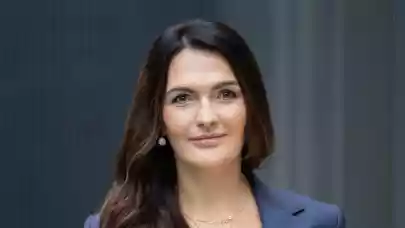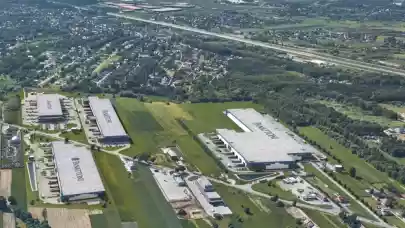
Last year was a demanding period for the office market and a test for us, which we managed to successfully pass, says Katarzyna Zawodna-Bijoch, President and CEO at Skanska’s commercial development business unit in Central & Eastern Europe (CEE). In 2022, we will witness safe and futureproof workplaces, new technologies as well as Environmental, Social & Governance (ESG) areas becoming increasingly important, with the latter being subject to continuous intensive analyses as a business trend.
Demand up, supply down: investment market
"In 2022, we expect the market to improve, and a ‘new normal’ to crystalize. Quite a lot of time has passed since March 2020, when the pandemic stroke in Europe. Certain trends and changes are already very apparent. We can, without any doubt, note that the pandemic has significantly affected investment processes in the commercial market, both for developers and investors", explains Katarzyna Zawodna-Bijoch, President and CEO at Skanska’s commercial development business unit in CEE. "On one hand, we have observed an increase in investors’ activity over the last 12 months. They have been searching for new investment products more frequently, and their expectations of building quality are on the rise, particularly in terms of the ESG criteria. On the other hand, we noticed that developers have become more cautious about starting new projects. Consequently, we have a situation that will lead to a supply gap in the next 2-3 years, especially in large cities. It will be caused by a very limited number of new core assets able to meet investors’ high expectations."
ESG-related aspects will have an increasing impact on decisions made by investors. This is influenced both by the growing awareness in terms of sustainable development and environmental impact and also by the need to comply with ESG reporting requirements. Investment strategies will be closely connected to the purchase of products and cooperation with the businesses that meet relevant environmental, social and governance criteria. This will have a significant impact on the shape of the real estate market in 2022. According to the Global Capital Markets 2022 Investor Outlook report by Colliers, the office market will be among the top three markets preferred by investors in the EMEA region (alongside the logistics and the BTR/Multifamily sectors).
Tenants look for flexible solutions
Another trend to become a significant one is tenants’ growing demand for flexible office spaces, adapted to dynamically changing models of work. This refers both to entities that have been forced to delay their decision-making processes due to the pandemic, as well as to companies that will choose this region of Europe as a location for their new service centres. There is a growing trend for relocating from distant offshore locations to those perceived as safer destinations for business continuity and development. In this respect, countries in the region of Central and Eastern Europe, particularly Poland, are definitely a point on the map not to be missed.
One of the growth stimuli for this industry is the increasing demand for IT services within hybrid working models – which will be continued, to some extent, in the long term. The extent will vary depending on the industry as well as the individual needs of organizations. However, it is important to note that this does not significantly reduce the need for physical office space. This is reflected in the growing interest in solutions that combine traditional and flex office space.
"Tenants are looking for flexible solutions that allow them to align the office space with their current needs – of both the whole organization and individual employees. A growing number of companies chooses the core&flex model, which combines traditional office space with flexible solutions, thus allowing for dynamic space management", clarifies Katarzyna Zawodna-Bijoch. "Regardless of the size of an office, the space of today needs to be designed in a way that makes it multi-functional. These changes are exemplified by quiet rooms – they are more comfortable than small traditional phone booths. This solution will be based on micro-offices, which will constitute a part of broader office space, where people can feel comfortable, for instance, while participating in video and audioconferences. There will also be rooms that facilitate creative work (such as brainstorming), cooperation and innovation processes, as well as space dedicated to team-building activities and less formal meetings", she adds.
Safety and technologies are now more important than ever
The trends that used to function solely as premium solutions are also increasingly popular – currently, they have become tenants’ standard expectations. A good example of these trends is highly demanding certification, such as the WELL Core & Shell or the WELL Health-Safety Rating certificates. The latter is especially desired by tenants due to the current global situation – it confirms that office spaces are fully safe for their users.
"We are convinced that top quality, healthy and sustainable offices are the future. The adjustment to the new reality is still underway – it is a long-term process. The main goal of developers should be the deepest possible understanding of clients' needs and a close dialogue, which allows to jointly develop tailor-made, safe solutions that meet their requirements – in terms of creating attractive workplaces, encouraging employees to return to their offices as well as developing futureproof projects that investors are interested in", adds Katarzyna Zawodna-Bijoch
Moreover, innovative technological solutions will undergo further development too. These include, for instance, contactless entry to an office as well as options to check the whereabouts of co-workers, adjusting the lighting and temperature to the needs of users, or booking a room. As technology is a crucial aspect of hybrid work, it has become an integral part of office space. Office rooms need to be equipped in a way that enables working effectively and interacting with co-workers in the new reality.
New year’s challenges
The new year will also bring a number of challenges for developers, including rising inflation, increasing prices of construction materials (caused by the pandemic) and disrupted supply chains, reduced availability of talent or low supply of land in attractive locations. These will all be important factors, which will impact both the changes in the working models as well as the condition of the real estate market.
"The current macroeconomic situation is dynamic and full of challenges. Given that, we carefully monitor all markets where we operate. We have been developing new investments in Central and Eastern Europe for many years now. Our projects respond to contemporary market trends. Consequently, I am convinced that we can offer products that meet the current needs of our clients. We constantly analyze the markets where we operate, and we are gradually starting new investments. In the entire region, we have over 180,000 square meters of office space under construction within eight projects, including about 110,000 square meters in Poland alone", sums up Katarzyna Zawodna-Bijoch.



